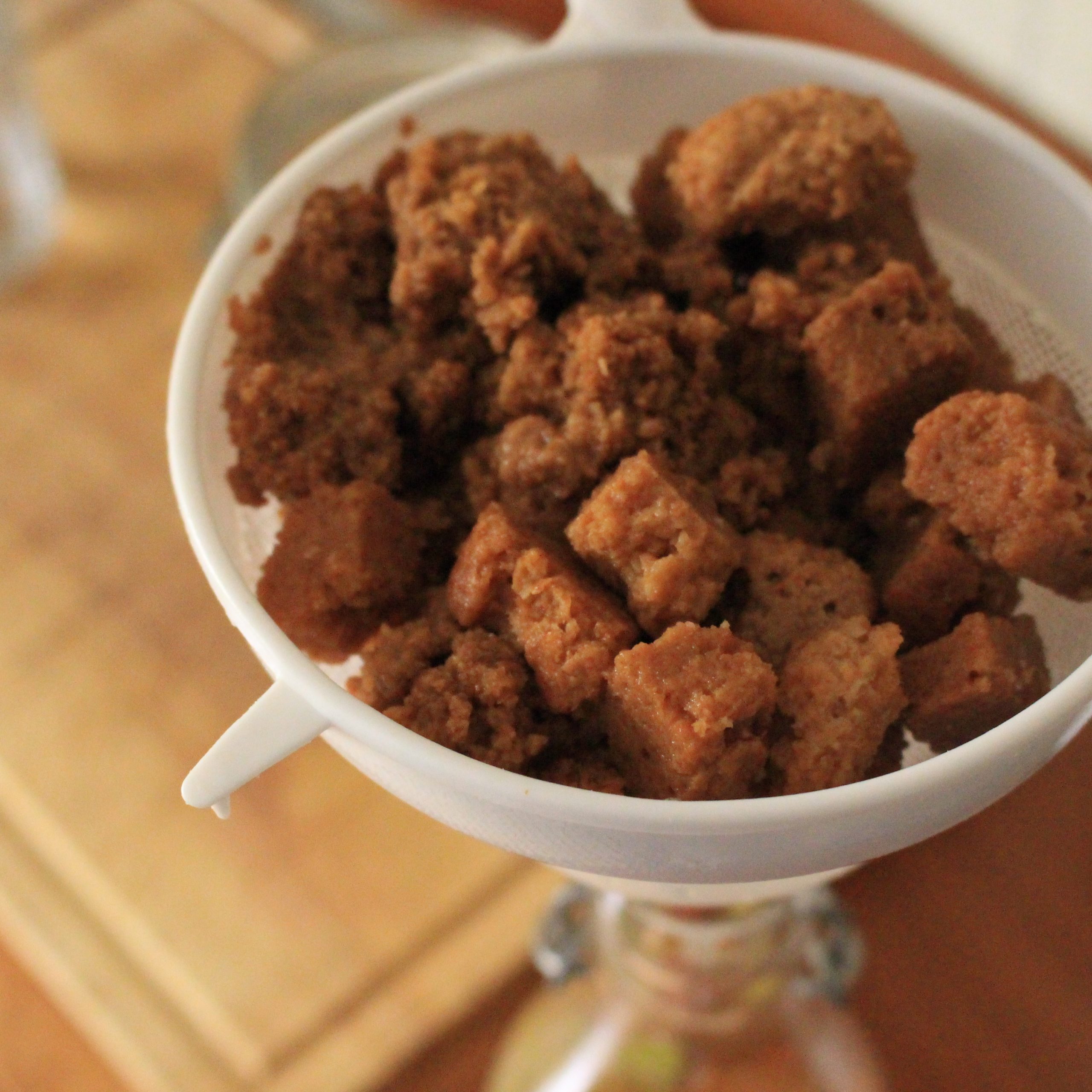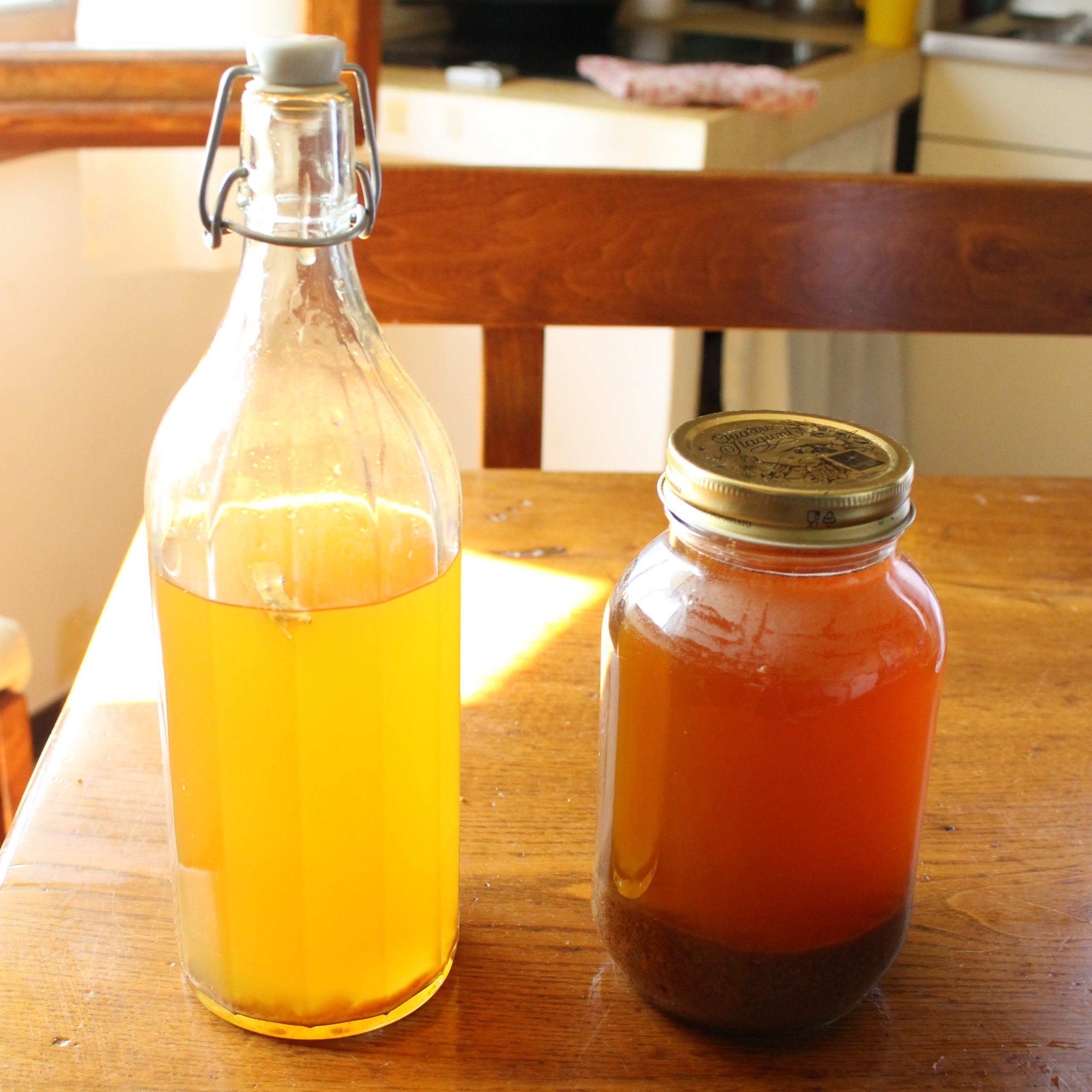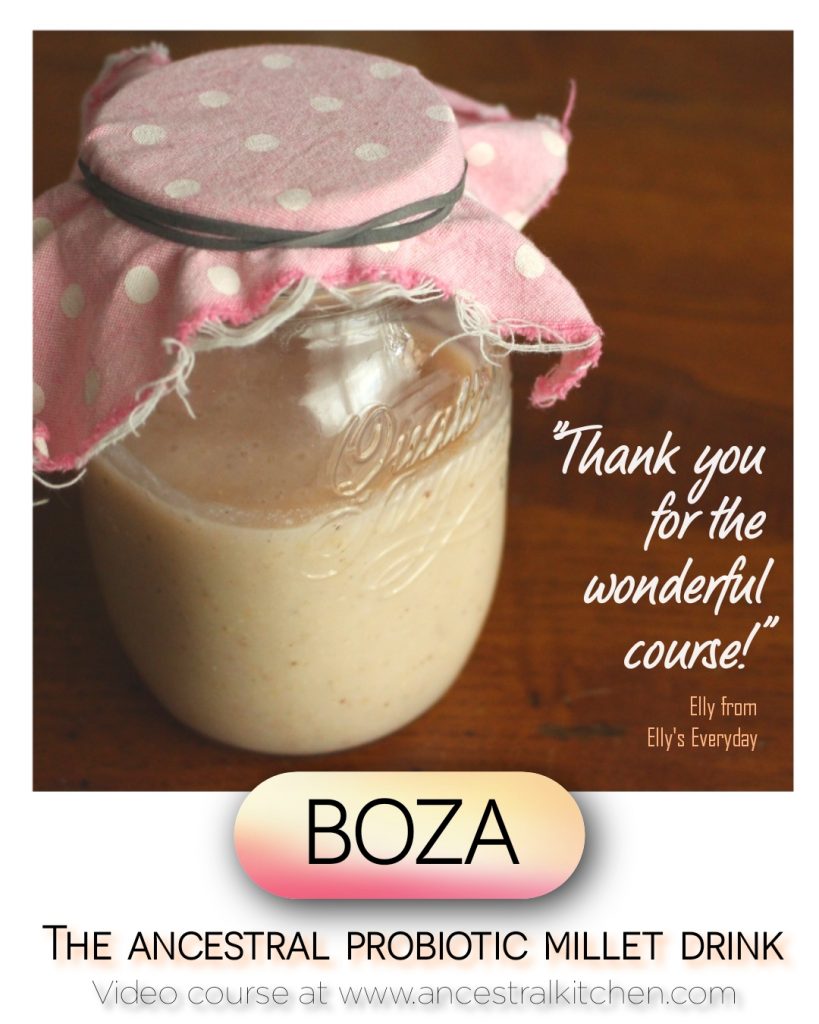
Russian Bread Kvass is a favourite in our house.
It’s sweet, it’s sour, it’s bubbly, it’s rich. And that’s before you’ve flavoured it – which you can do with fruit, herbs, spice and roots.
Kvass is a less-well-known cousin to water kefir or kombucha. It’s easy to make and full of probiotic goodness. All you need to start it off is some sourdough rye bread. And you can keep that bread – using it over and over; it’ll just get stronger and tastier.
My hubby, when I first started making it, commented that it tasted like Cola – indeed it is known as ‘Russian Cola’, comes from the Slavic and Baltic regions, and has been around for over 1000 years.
Some recipes you can find online use bread yeast to start the fermentation. I don’t and I’ll show you that you don’t need it – wild yeasts captured in the sourdough and omnipresent in our environment do a fine job of weaving their magic on this drink without the need for industrial yeast.

A by-product of yeast fermentation is alcohol, and kvass is slightly alcoholic – usually 0.5-1.0%. In the summer it’s refreshing straight from the fridge and in the winter, it’s a warming, fizzy treat!
Russian Bread Kvass
Ingredients:
- 1 cup of cubed sourdough rye bread (can be stale)
- 1/2 cup sugar
- 3 to 4 cups of non-chlorinated water
- (Optional) Herbs/spices/fruit/flavourings/extra sugar or honey (for flavouring the second stage of fermentation).
Equipment:
These specific pieces are not strictly necessary, but will help you a lot.
- 1 litre/1 quart glass jar with lid
- small plastic sieve
- small funnel
- 1 litre/1 quart swing-top glass bottle (for the second stage of fermentation)

Let’s look more closely at what you need:
Sourdough rye bread
Sourdough rye bread is traditionally used as the starter for Russian Kvass.
If you don’t currently make this, it’s a great opportunity to give it a go. I have made sourdough rye regularly for a decade and have a lot of resources that can help you. Start with my post How to Make Sourdough Rye Bread From Scratch and listen to my podcast episode Rye Sourdough Bread: Mastering the Basics.
If you aren’t up for making a rye sourdough, go find a baker who is. Supporting local artisanal bread is such a good thing!
You only need 1 cup of bread cubes – not much – and it can be stale. The end of a well-loved loaf is perfect!
Sugar
I use a mix of two-thirds whole dark brown sugar and one-third golden sugar. This gives the resulting kvass a dark colour and a rich, deep flavour that compliments the sourdough rye extremely well.
You don’t need to do this though; use whatever sugar you have to hand or fancy trying.

Isn’t this a lot of sugar?
When I started making fermented drinks, I was concerned about the sugar content. I’m not anymore.
How come?
- I make them sour (much more so than the ‘average’ guest to my house cares for!!) which means more of the sugar has been transformed into by-products.
- I know sugar is essential to the process of fermentation and that the benefits of drinking fermented beverages far outweigh the minimal sugar imbibed in the process.
- I don’t drink these beverages in quantity…even my son (who drinks the most in our house) only has 2 small cups a day. You can hear me talking about this in my podcast episode What Fermented Drinks Can I Make?
I haven’t tried using honey or other liquid sweeteners. If you want to give these a go, I suggest you wait for your second or third round of the drink to give your starter some time to get strong and you some time to get used to how it should work.
Water
Your water should be non-chlorinated. Filter it, or failing that, pour and leave tap water out overnight. A lot of kvass recipes suggest boiling the water first to remove potentially harmful particles. I boiled my water the first time I did this, but have not done so subsequently and have not had problems, but please make your own mind up on this – if you feel more comfortable boiling, ensure the water has cooled to below 41C/105F before you add the sugar and bread.

Flavourings
This is where you get to be creative!
For the second fermentation you can add more sugar – in the form of honey, dried fruit or fruit and/or other flavourings.
Fresh mint is traditional and I love it, but I’ve also added fresh rosemary.
Ginger works well, helping to make it more bubbly and give it a zing and combines well with honey or fruit.
I’ve also used coffee grinds, cacao nibs, cardamon pods, fennel seeds and my current favourite – liquorice root in stick form.
The process:
Stage one – Preparing the first fermentation
- If you wish to sterilise your 1 litre/1 quart glass jar you can do so by washing it out and placing it in an oven at 120C/250F for 15 minutes. Let it cool.
- Toast 1 cup of sourdough rye bread in the oven at 120C/250F for 1-2 hours. You want it dried out and crispy but not burnt. Let it cool.
- Fill your litre/quart glass jar with water (previously boiled and cooled, if desired) two thirds full.
- Add half a cup of sugar and stir until dissolved.
- Add the cooled, toasted bread to the jar and stir gently.
- Lightly screw a lid on or cover the glass jar and leave it somewhere warm and out of direct light to ferment. Stir once a day.
- Check it after 3 days (put a note in your calendar!) and taste. If it is sour enough for you, you can proceed to stage two, if it still tastes strongly sweet, leave it to ferment further (to produce a soured drink (the way we like it) mine usually takes 6-7 days).
Stage two – Decanting and (optional) second fermentation
- Prepare the 1 litre/1 quart swing top bottle by cleaning and sterlising as above.
- Put the funnel in the neck and balance your sieve on this (see below).
- Pour your fermented kvass through the funnel/sieve, so that the kvass ends up in the bottle and the bread cubes are caught in the sieve. You may have to hold the sieve still and/or use a spoon to scrape out some of the bread to complete this.
- Remove the funnel/sieve/bread and put to one side.
- Add your optional second fermentation sweeteners/flavourings to the bottle. Cap the top. If necessary (it is with honey) gently agitate the bottle to mix.
- Leave this bottle somewhere warm and out of direct light to ferment.

It’s ready to drink from now onwards, but will improve over the next 24 hours. Check it regularly, releasing the gas in case it has gotten very bubbly. I find it’s best drunk within 3 days. Remove it to the fridge if you want to preserve – this will virtually stop the fermentation but will also mean it looses some of its fizz.
Stage three – Making the next batch
The next batch of bread kvass is ready to make as soon as you’ve strained the bread from the liquid at the beginning of stage two. You will use this bread as a starter in your next batch.
- Wash your previously used 1 litre/1 quart glass jar, or use a new one.
- Return to stage one above and repeat the process from the third paragraph. I’ve found it is possible to use less sugar on subsequent fermentations, so feel free to experiment with quantites and the time they take to ferment.
If you don’t want to immediately make a new batch of kvass, you can keep the starter in the fridge for a few days until you’re ready.
For more on fermentation and ancestral cooking, check out my podcast Ancestral Kitchen Podcast.
You might also like:
What Is Boza Drink? (another historic European fermented drink)
How To Make Sourdough Rye Bread From Scratch
What Fermented Drinks Can I Make? (podcast episode)


Bring ancient grain baking into your kitchen!
Download my free 30-page guide with five healthy and tasty 100% ancient grains recipes.


Great and easy recipe to follow! I now use this as a reference for when I make my kvass.
Thank you Deirdre! I hope you’re enjoying the fab drink!
I haven’t made this kvass yet although I have made it with beets. I really enjoyed it. I had a couple questions. why does it need to be rye bread? could it be another dark bread? is the toasting essential? or could I just use the bread as is. I have some homemade sourdough squash bread from a friend that I thought might work for this but I don’t currently have a stove, just a microwave so that’s why I ask about the toasting.
Hi MaryLou,
Rye bread is traditional – the kvass comes from Russia where rye is a main crop. You could try other breads though for sure. Toasting is not essential, but it does bring a lot of additional flavour to the drink due to the ‘sugaring’ reactions toasting creates. Hope this helps!
Alison
Made this recipe three days ago, but I’m still not seeing any reaction or yeast, reproduction or activity. I ended up putting raisins in it yesterday as I have heard raisins. Also have yeast on them. Oddly, still nothing. Curious to know how yeast can survive inside the sourdough bread, when it’s completely baked to death Before you use it?
I’d say be patient, stir every day and if possible up the temp in your space. I have made this many times (and so have others) and it does work. Adding raisins is a good idea to potentially speed it up. Yeasts and bacteria are present on all foods and in the air…and they do the work even when the bread isn’t ‘raw’.
[…] tea was first brought to Russia and Eastern Europe in the late 1800s. It was called tea kvass or Russian kvass. Russian doctors are said to have given tea kvass to their patients as a digestive aid and general […]
Yes you are correct Shane, the yeast will be baked out the bread it is just a flavour added to the water as it draws in natural yeasts which are airborne but subsequent brews will be enhanced as the bread taken out will still have active yeast within it so should start the fermentation off much faster, I would have thought but not by experience, I must add, that on subsequent batches the addition each time of a quarter portion of more fresh bread would keep the flavour enhanced.
This adding of some ‘new’ bread is a good idea. Thanks Gary.
I’m wondering where does the wild yeast in this recipe actually come from? Since all ingredients are heated/processed some way before. Where does natural yeast come into the picture? Thanks!
Hi Eline,
There are yeasts and bacteria all around us, in the air. My educated guess is they come from our environment and also the ones that have already colonised the bread. The kvass ferments very well, so they are there!
Hi everyone,
I am from Russia and I have tried all kinds of kvass, as each family does it their own way. So here are some thoughts I want to add.
1- your bread does not have to be sourdough. Any bread can be used. As a sourdough baker I obviously prefer it as well, but commercially made yeast breads were prevalent during my childhood and everyone used them just fine to make their kvass. Quality of your bread influences the taste, and while I have used non sourdough bread in the past with great success, I would not use any of those tasteless sliced sandwich breads from the supermarkets.
2- it does not have to be rye bread. Rye is sort of traditional and is what we used to make kvass in my family, but my friend’s family always made kvass with white wheat bread and it was really good too. The colour of your kvass will be greatly influenced by bread color. So will the taste, but not in a bad way, necessarily, it will just have subtle differences. I have a linen bag hanging in my kitchen where I put leftover, hardened or stale bread pieces and that’s what I use for kvass – wheat, rye or a mix. I would think any grain bread, like spelt or kamut, should work just as well, squash / zucchini / corn bread – not sure, never tried.
3- you can add a tiny bit of baking yeast (small amount on the tip of the knife) or a spoonful of sourdough starter to start off your fermentation or wait a bit longer till wild yeast establish themselves. Raisins are also a good idea. I add rye starter.
Hope this helps.
Thanks for this wonderful information. I have used other breads too; a different flavour for sure! I have also tried with sourdough starter, but prefer the taste without it.
Hello hello Allison,
You are adorable, you are such an inspiration in all levels. Thank you for sharing. you are changing my life.
I just read your newsletter and would like to make the Beet Kvass, can you please tell me how to do it? This is the recipe for bread kvass but have no idea when and how to add the beetroot and the garlic and the seeds you mentioned m, in which step of the process and in which form?
Would appreciate some guidance regarding the steps and the process for making beet kvass specifically. Many many thanks
Hi Barbara, thank you for your kind words. I am happy to hear you are enjoying my work! I have not yet written my process for beet kvass up yet. I checked the web. This site has a recipe similar to how I do it: https://eatingeuropean.com/how-to-make-beet-kvass/ Let me know how you get on. Alison
Afaik yeast dies at 40 celsius. This info saved me quite some ingredients when I was about to put my starter in hot water 🙂
I also prefer to add boiling water to the toasted bread and leave it for 24h before adding sugar and starter. I believe kvass taste is richer, more “bread’y”.
I know some people prefer soaking the bread in hot water. Enjoy!
I am unclear what the “starter” is for subsequent batches. Is it just a small amount of the first batch that is saved? If so, what amount should I save as the starter, and then what do I mix it with for the next batch? Do I need to add the bread again?
The bread is the starter. Once it has been strained from the first batch it goes into the next one. Hope this helps.